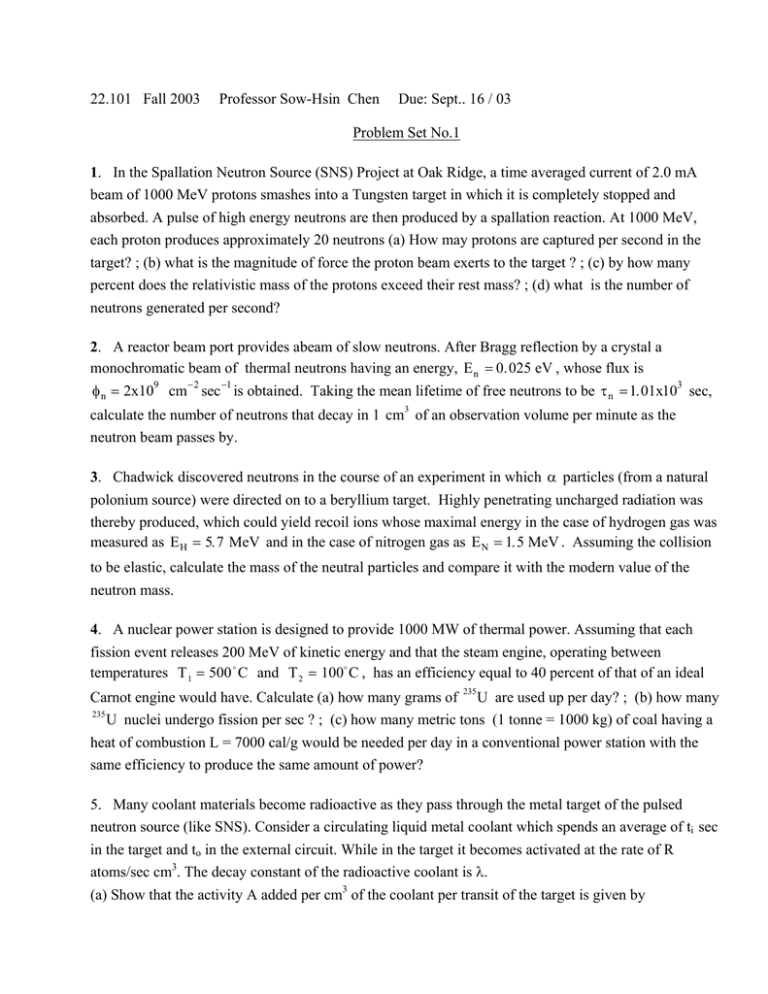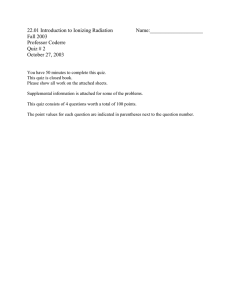22.101 Fall 2003 Professor... Problem Set No.1
advertisement

22.101 Fall 2003 Professor Sow-Hsin Chen Due: Sept.. 16 / 03 Problem Set No.1 1. In the Spallation Neutron Source (SNS) Project at Oak Ridge, a time averaged current of 2.0 mA beam of 1000 MeV protons smashes into a Tungsten target in which it is completely stopped and absorbed. A pulse of high energy neutrons are then produced by a spallation reaction. At 1000 MeV, each proton produces approximately 20 neutrons (a) How may protons are captured per second in the target? ; (b) what is the magnitude of force the proton beam exerts to the target ? ; (c) by how many percent does the relativistic mass of the protons exceed their rest mass? ; (d) what is the number of neutrons generated per second? 2. A reactor beam port provides abeam of slow neutrons. After Bragg reflection by a crystal a monochromatic beam of thermal neutrons having an energy, E n = 0.025 eV , whose flux is φ n = 2x109 cm−2 sec −1 is obtained. Taking the mean lifetime of free neutrons to be τ n = 1.01x103 sec, calculate the number of neutrons that decay in 1 cm3 of an observation volume per minute as the neutron beam passes by. 3. Chadwick discovered neutrons in the course of an experiment in which α particles (from a natural polonium source) were directed on to a beryllium target. Highly penetrating uncharged radiation was thereby produced, which could yield recoil ions whose maximal energy in the case of hydrogen gas was measured as E H = 5.7 MeV and in the case of nitrogen gas as E N = 1.5 MeV . Assuming the collision to be elastic, calculate the mass of the neutral particles and compare it with the modern value of the neutron mass. 4. A nuclear power station is designed to provide 1000 MW of thermal power. Assuming that each fission event releases 200 MeV of kinetic energy and that the steam engine, operating between temperatures T 1 = 500 C and T 2 = 100 C , has an efficiency equal to 40 percent of that of an ideal Carnot engine would have. Calculate (a) how many grams of 235 U are used up per day? ; (b) how many 235 U nuclei undergo fission per sec ? ; (c) how many metric tons (1 tonne = 1000 kg) of coal having a heat of combustion L = 7000 cal/g would be needed per day in a conventional power station with the same efficiency to produce the same amount of power? 5. Many coolant materials become radioactive as they pass through the metal target of the pulsed neutron source (like SNS). Consider a circulating liquid metal coolant which spends an average of ti sec in the target and to in the external circuit. While in the target it becomes activated at the rate of R atoms/sec cm3. The decay constant of the radioactive coolant is λ. (a) Show that the activity A added per cm3 of the coolant per transit of the target is given by ( A = R 1 − e −λt i ) (b) Show that after m cycles the activity per cm3 of the coolant leaving the target is 1 − e−λt )(1 − e−mλ(t +t ) ) ( =R i Am 1 − e−λ(t i +t o ) (c) What is the maximum coolant activity at the exit? i o







